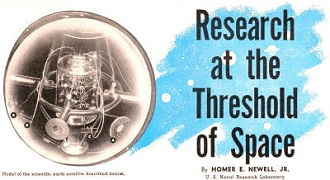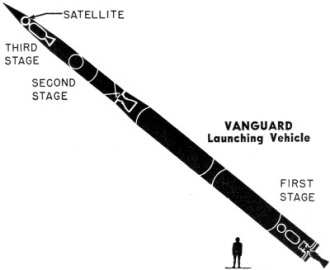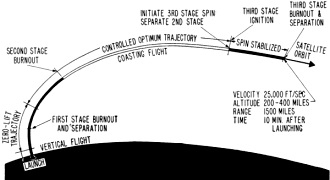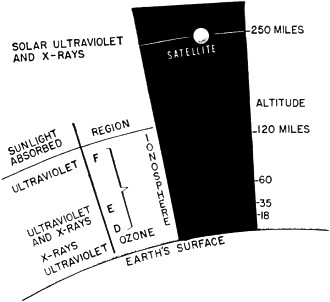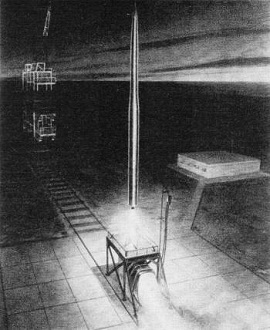Research at the Threshold of Space |
|
Atmospheric scientists suspected as recently as early 1957 that Earth's upper atmosphere (ionosphere and beyond) temperature might be around 1,000 °K. I say "suspected" because we had not yet launched instruments there to make actual measurements. Soundly posited and agreed upon theory was validated a short time later when sounding rockets reliably reported a maximum of about 1,300 °K in the upper ionosphere. We did not know for sure what electromagnetic wavelengths and their respective energy densities would be outside the protective layers of gases encompassing Earth. Much more was known about the depths of the planet's oceans than of its atmosphere. Scientists knew that life was abundant below the water's surface but did not know what, if any, life existed at altitudes any greater than the tallest mountain. Outer space, devoid of everything we consider essential to support life as we know it, would be a hostile environment for humans or even electronic instrumentation. It is always interesting to recall that while you only need to dive 33 feet below the water's surface to double the ambient pressure, you need to go 18,000 into the atmosphere to halve the pressure. Beginning in 1957, a consortium of more than 60 countries banded together to discover as much as possible about outer space by building instrumentation and launch vehicles during the International Geophysical Year (IGY, which actually lasted for around 18 months). Science magazines like Radio & TV News spilled a lot of ink onto their monthly pages to keep the public apprised of data being collected. The results are inarguably responsible for the occupation and exploitation of space-based communications and observation systems that rapidly ensued. Research at the Threshold of Space Model of the scientific earth satellite. The instruments indicated by the lettering and numbers on the satellite are: A. Solar cell. peak memory reset. Solar cell operating on energy from sun will reset peak memory storage unit once each orbit on transition from darkness to daylight. B. Ion chamber, narrow band for ultraviolet detector. Peak ultraviolet sensitivity at the hydrogen Lyman-alpha line. C. Thermistors, semiconductors made of various metal alloys, used for temperature measurement. The resistance changes with temperature. D. Erosion gauge, nichrome ribbon evaporated on glass. Measures surface erosion caused by impact of micrometeorites. Resistance increases as film becomes pitted. 1. Minitrack transmitter. Supplies r.f. link for continuously telemetering the data from the satellite to ground. Operating life about 2 weeks with batteries. 2. Meteor storage, meteorite collision memory. Magnetic cores are used to store the number of "counts" from the meteoritic collision detector and transmit signals representing four decimal digits on four telemetering channels. 3. Telemetry coding system. Successively samples various signal input channels and appropriately modulates the Minitrack radio tracking transmitter for transmitting scientific data to a ground recording station. 4. Lyman-alpha storage, peak memory unit. Magnetic cores are used to store and code the telemetering system with a signal representing the maximum input value reached during one satellite orbit for subsequent readout when passing over recording stations. 5. Meteoritic collision amplifier. Amplifier output signal from a sensitive microphone is used to detect any collision that may occur with micrometeorites and provides input to the meteoritic storage counter. 6. Lyman-alpha unit. Current amplifier for measuring the amount of ionization produced by far ultraviolet solar flare radiation. 7. Mercury batteries used as the power source for all instruments. By Homer E. Newell, Jr. U. S. Naval Research Laboratory Electronics in the earth satellite and what we expect to learn from the "laboratory in space." Dwelling at the surface of the earth man moves about in what has often been called an "ocean of air." If all of the air in the atmosphere were at sea level temperature and pressure, this ocean of air would be about five miles thick. In fact, however, the atmosphere rises some hundreds of miles to merge at some unknown level with almost, but not quite, empty space. Below about 60 miles, atmospheric temperature varies with height between warm and very cold, but at higher altitudes gets very hot, probably more than 1000 K (Kelvin scale-degrees = degrees C + 273.1 above 150 miles. At the same time the pressure and density fall off exponentially with height, so that at 60 miles the air is only one-millionth as dense as at sea level, and at 200 miles is probably only 10-11 as dense as at the ground. At some altitude above 200 miles the mean free path of the air molecules becomes so great that any molecule speeding vertically at more than the escape velocity will depart from the atmosphere into interplanetary space without colliding with any other air molecule. This height marks the beginning of what is often called the "exosphere," and may be termed the threshold to space. Since the dawn of history, and earlier, man has looked out through the atmosphere at the sun, the moon, the planets, and the stars. The science of astronomy and astrophysics is based on observations made through this window of air, which at first thought may seem to be perfectly transparent. The fact of the matter is, however, that this window of air is transparent only in certain restricted regions of the wavelength spectrum. The visible wavelengths, parts of the infrared, and parts of the radio-frequency spectrum penetrate the atmosphere to reach the ground, but the remainder is cut off completely. For example, none of the solar or stellar radiation below about 2900 A (angstrom unit =10-8cm) ever reaches the surface of the earth. The astrophysicist is, therefore, prevented from observing the sun or the galaxy in regions of the spectrum that could be highly revealing. Even in the regions in which it is transparent the atmosphere imposes some restrictions. Because of turbulence and dust, the ultimate accuracies to which the astronomer can attain are limited quite severely, considering the present state of the art. Geophysicists have studied the upper atmosphere and events occurring in it for over half a century now. Pressure, temperature, density, winds, the aurora, airglow, the ionosphere, meteors, cosmic rays, air composition, the earth's magnetic field, all have come under this scrutiny. During most of this period, all of the observations were made from the ground or near the ground. For a long time the highest altitudes attainable were those reached by balloons. As a result many of the conclusions about the high atmosphere were obtained in a highly indirect fashion. Often the theory connecting the observational fact with the ultimate object of study was highly involved and open to considerable doubt. In this respect the sounding rocket has been of great value to the geophysicist. During the past ten years it has been possible in such rocket vehicles to place measuring instruments in direct contact with the upper atmosphere. These rocket measurements have given the geophysicist the data needed to correct many of the theories used in interpreting ground based observations. Moreover, they have provided data unobtainable otherwise: ultraviolet and x-ray radiations from the sun; levels of ionospheric currents; high altitude values of the earth's magnetic field; chemical and ion composition of the air; auroral particles; very low energy and highly ionizing cosmic rays; and micrometeorite counts. Vanguard rocket size compared to that of a man. Artist's concept of the satellite preliminary trajectory. During his study of the earth's atmosphere the geophysicist has had a growing interest in things beyond the atmosphere. The sun, of course, is important because it is the single greatest source of energy input into the atmosphere. The auroras are now believed to be caused by charged particles entering the atmosphere from interplanetary space, originating in the sun. It is also thought that magnetic storms are associated with electric currents existing far beyond the earth's atmosphere. Meteors and micrometeorites come from interplanetary space. Whereas some cosmic rays may come from the sun, many of them probably arrive from galactic and intergalactic space. Thus the astronomer, the astrophysicist, and the geophysicist all have a great interest in looking into outer space without having to look through the atmosphere. The astronomer would like to place his instruments above the air where seeing would be unimpaired. The astrophysicist would like to study the sun and stars from above the atmosphere so that he can observe them in important wavelengths that do not penetrate to the ground. Finally, the geophysicist would like to observe those solar and particle radiations and other phenomena which affect the atmosphere, the earth, or its magnetic field. The vertical sounding rocket can be used to a limited extent for such observations. Its principal value, however, is for studying events occurring within the atmosphere, particularly for making measurements as a function of altitude at essentially a single instant of time. The glimpse that it can afford of conditions above the atmosphere and in outer space comes only near the peak of flight, and is brief, whereas most of the desired observations at or above the threshold to space become of real value only when carried out over extended periods of time. Examples are: monitoring the ultraviolet light from the sun over sufficient time that the data can be correlated with weather effects; and monitoring flare activity in the sun so that it can be correlated with ionospheric, magnetic, and auroral effects. An observing platform at the threshold to outer space would meet the needs of astronomer, astrophysicist, and geophysicist alike. But one cannot just place such a platform at some point in space and expect it to stay there. Even if it were motionless to begin with, the gravitational attractions of the sun, the earth, the moon, and the planets would cause it to move. If it were much closer to the earth than to any of the other bodies in the solar system, it would simply fall to the ground. If it were far removed from any of the planets, the sun would be the controlling factor, and the platform would fall into the sun. The conclusion is that such an observing platform will necessarily be in motion, and the problem is to find some motion which does not destroy the usefulness of the platform for making observations. The moon is obviously a highly acceptable platform for making physical observations outside the earth's atmosphere. In revolving about the earth the moon stays well outside the earth's atmosphere, and since it has no atmosphere of its own, it would be an ideal spot to locate telescopes, spectrographs, light and particle counters, etc. There is, however, some difficulty associated with setting up operations on the moon. One is led, therefore, to the idea of creating an artificial moon revolving close to the earth, carrying automatic equipment for collecting data, and a radio transmitter for sending the data to the ground. This can be accomplished using suitably designed rockets. International Geophysical Year The idea of creating an artificial satellite of the earth is far from new. For many decades rocket engineers have had such a thought in the back of their minds. Many enthusiasts have regarded the creation of a space platform as a principal objective of rocket development. The immediate motivation for the current United States artificial earth satellite program is to be found, however, in the International Geophysical Year. From the beginning of July, 1957 to the end of December, 1958 about 50 nations will unite in an attack upon various important geophysical and solar problems. The participation of the United States in this program is under the direction of the United States National Committee (USNC) for the IGY, established by the National Academy of Sciences. Their observations will be made in a coordinated fashion from stations covering the entire globe. It is expected that these coordinated and correlated observations will lead to a number of major breakthroughs in such fields as meteorology, ionospheric physics, aurora and airglow, solar activity, cosmic rays, geomagnetism, latitude and longitude, oceanography, glaciology, gravity, and seismology. In addition to scientific value, such breakthroughs could be of great practical importance, possibly leading to better weather forecasting, improved radio communications, better navigation, and more effective means of mineral prospecting. A large part of the International Geophysical Year effort will be devoted to a study of the upper atmosphere and the sun. To this end the United States National Committee (USNC) for the IGY has generated rocket and satellite programs. The former program is managed by a Technical Panel on Rocketry, created by USNC, and involves the firing of some 200 vertical sounding rockets during the IGY. The latter program is managed by a Technical Panel on the Earth Satellite Program (TPESP), also established by USNC, and involves the launching of a small number of instrumented satellites during the IGY. Diagram showing the distribution of ultraviolet radiation and layers of ionosphere with respect to the satellite position. In the management of the scientific aspects of the satellite program, the TPESP has set up two working groups, one on tracking and computation (WGTC) and one on the internal instrumentation of the satellite (WGII). The WGTC acts as adviser to the TPESP on such things as optical and radio tracking of the satellite, on the reduction of tracking data and the computation of an orbit and ephemerides for the artificial moon, also on the use of such data for geodetic studies and for determining the density of the upper atmosphere. The WGII advises on experiments requiring operating instruments in the satellite. This working group has received almost three dozen proposals from various research agencies for experiments to be done in IGY satellites. The WGII is studying these proposals to assess their scientific importance, their appropriateness to IGY, their feasibility in a satellite, and whether or not they are best done in a satellite. Out of these studies there is developing a sort of priority listing of the proposed experiments, and eventually the TPESP will select those experiments actually to be flown in IGY satellites. Instrumentation for Satellite The Launching Operations: The IGY satellites will be launched from Cape Canaveral by means of a finless three-stage rocket. Rising vertically at first, the rocket will start tipping shortly after take-off, moving a little to the south of east in a trajectory that will ultimately lead to projecting the satellite into an orbit inclined at about 35° to the equator. The first stage will be discarded at the end of its burnout, and the second stage will then carry the third stage rocket with the 20-inch, 21.5-pound satellite attached to its nose up to 300 miles altitude about 700 miles from the take-off point. By the time the second stage with cargo has reached its peak altitude it will have been tipped over to the horizontal, thus aiming the third stage solid-propellant rocket along its intended orbit. At this time the third stage will be spun to provide stability, separated from the second stage, and fired. Following burnout of the third stage the satellite package itself may or may not be separated from the empty rocket depending on the requirements of the experiments being performed. If the satellite and the third stage rocket are separated, this will, in effect, result in two satellites, since the empty rocket casing will also continue to revolve around the earth in an orbit of its own. During these launching operations, it will be necessary to monitor the vehicle and its equipment. This will be done both by tracking and by telemetering. For the tracking, ballistic cameras and theodolite systems, radar, and the Minitrack system to be described later will be used. Telemetering will be accomplished by means of what have now become conventional techniques, using various combinations of frequency, pulse-position, and amplitude modulation. Especially during the program of test firings prior to the first actual attempt to create a satellite there will be a need for extensive telemetering. Optical Tracking of the Satellite: It is planned to make the first satellite in the form of a highly polished, silvery sphere, 20 inches in diameter. If the launching goes as planned, the orbit of the satellite will lie entirely above 200 miles altitude but may extend out as far as 1500 miles. At the nearer altitude, such a satellite should be just barely visible to the naked eye if present in the neighborhood of the observer within about an hour after sunset or before sunrise. With ordinary binoculars, on the other hand, the sphere should be quite easily visible, and at the request of the TPESP, the Smithsonian Astrophysical Observatory (SAO) is organizing an amateur program of looking for the satellite. In this program, called "Moonwatch," the observers will use binoculars. At each station a large number of binoculars will be set up so that their fields of view overlap forming an observational fan crossing the sky from north to south. Suitable timing will be provided so that the time as well as position of passage across the fan can be determined. This program of visual observing is also being extended internationally so that there will be stations located all around the world throughout the belt over which the satellite is expected to pass. Artist's conception of the three-stage launching rocket that will place the scientific satellite in its orbit. Vehicle will resemble giant 30-callber rifle shell. The primary purpose of the visual program, however, is to acquire the satellite and to get a rough estimate of its orbit. Precision tracking, to provide data for use in geodetic and air density studies, will be carried out using specially designed Schmidt cameras. These instruments, with 20-inch aperture and 20-inch focal length, will be able to photograph the satellite against the star field, even at the 1500-mile distance, positioning the satellite to within seconds of arc and a millisecond of time. These photographic stations are also being set up by SAO, and will be spread around the world in the expected orbital belt. About a dozen such stations are presently planned. Radio Tracking of the Satellite: Optical observation of the satellite depends on a number of factors not under the control of the observer. As mentioned the sphere can be observed only at certain favorable times, so that any given station will be able to sight the satellite infrequently. The chance of such an optical sighting will be further reduced by poor weather. Radio tracking can be achieved night or day, independently of weather. Moreover, a single antenna beam can be made to cross the sky from horizon to horizon. With a group of such beams running across the entire orbital belt a sort of radio picket fence can be established to contact the satellite each time it crosses the fence. This is what is to be done with the Naval Research Laboratory Minitrack system. The Minitrack system uses radio interferometry. A continuously operating transmitter in the satellite will send a 108.0 mc. c.w. signal. This signal will be received at two antennas on the ground separated large number of wavelengths and compared in phase. The phase difference can then be used to determine one direction angle to the satellite. Two sets of such antennas at right angles to each other will be to us give the two angles needed to fix the direction from the ground station to the satellite. The radio fence planned will include stations running from Washington, D. C. to Santiago, Chile, a station in Antigua, British West Indies, and one at San Diego, California. This fence, including 11 stations in all, will provide on the order of 20 sets of observations per day. In the initial stages it is estimated that this data should suffice to determine the satellite's orbit to within a minute so of arc and a millisecond of time. After a couple weeks of observing, the data should be adequate to give the orbit to within about a third of a minute of arc, which is not as accurate as the photographic results, but nevertheless approaches precision quality. Using transistor circuitry a Minitrack transmitter has been constructed that weighs only a couple of pounds including the batteries for several weeks of continuous operation at from 25 to 50 milliwatts output. Telemetering: The optical observations of the satellite do not require any equipment in the satellite, although a light source in the orbiting vehicle would be of assistance. Satellite-borne equipment is required, however, to send back the information obtained by instruments in the sphere. For the IGY satellite. this radio telemetering will be accomplished by means of the Minitrack transmitter. The data obtained by the various sensing elements will be coded by a suitable premodulator into a waveform suitable for modulating the Minitrack carrier, and then impressed on the tracking signal. The percentage modulation of the carrier will be limited so as to maintain the integrity of the tracking during the telemetering operations. In some cases the telemetering may be carried on continuously along with the tracking. In others, a command signal from the ground may be used to turn on the satellite-borne scientific instruments for a limited time, simultaneous switching from the low-powered tracking oscillator to a higher powered tracking-telemetering oscillator. The premodulator to be used should be designed as a more or less integral part of the experiment to be performed in order to save space and weight. The particular approach to be used will be dictated by the experimental requirements. The University of Iowa has, for example, signed a lightweight magnetic tape recorder into an experimental setup for cosmic ray observations from a satellite. Using this, data can be stored throughout the entire satellite orbit and then read out as the satellite passes over an observing station. The Naval Research Laboratory has designed an extremely lightweight unit using magnetic cores and transistors. This premodulator provides 48 channels of information, comprising a total bandwidth of 10 kc., handles a wide variety of inputs, and with batteries for 3 weeks of operation weighs only a little over half a pound. Possible Satellite Instruments: For the IGY satellites, there are numerous experiments of genuine interest and importance. Only those, however, that can be performed with equipment weighing no more than a few pounds can be carried out. With this stringent weight requirement in mind, let us then consider existing instrumentation that might form the basis for an IGY satellite experiment. Temperatures on the surface of the satellite or in its interior might be measured with thermistors or similar gauges. These together with the necessary circuitry are extremely light, totaling only ounces. Likewise there are very light hot wire, ionization, and mechanical pressure gauges that could be used to measure pressures within certain regions in the satellite. This could be a means of checking on whether or not the satellite experiences a serious puncture by a meteor. There are lightweight microphones, which together with their circuitry weigh on the order of an ounce. These could be used to listen for the impact of meteors against the satellite surface. Very thin metallic coatings could be used as resistance elements in an electrical circuit and placed on the outer surface of the satellite. If these were to wear away because of encounters with particles in space, their resistance would increase. By measuring the change in resistance the rate of erosion could be determined. Very lightweight geiger counter circuits can be made for the observation of cosmic rays. Such counters and ionization chambers, seem to be a natural choice for measuring these extremely high energy particles. Photon counters and ionization chambers can also be used for observing the sun's radiation. For example, a satellite installation has been developed at the Naval Research Laboratory for monitoring the sun in the Lyman-alpha region of the spectrum. This equipment uses an ionization chamber for the primary measurement and a solar cell for aspect determination. With the power supply for two weeks of operation it weighs only a couple of pounds. Packard, of the Varian Associates, has studied the problem of constructing a nuclear resonance magnetometer for use in a satellite. He has concluded that such an installation can be made weighing a total of four pounds, including the power supply for about three weeks of operation. In this type of magnetometer, a proton rich substance, like water, is placed inside a coil of wire. The coil is energized for a short time with a strong current, causing the magnetic moments of the protons to align themselves with the coil field. The coil is then de-energized, after which the protons begin to precess around the direction of the earth's magnetic field. The precession gives rises to an alternating e.m.f. in the coil containing the water, which signal can be amplified and recorded. It so happens that the frequency of this signal depends on the strength of the earth's magnetic field, but not on its direction. By suitable calibration, then, the device can be used to determine the strength of the magnetic field in which it is embedded. The weights quoted by Packard make it practical to consider this instrument for use in an IGY satellite. Photocells can be built into a sufficiently lightweight installation for satellite use. Such an installation might be used for measuring the albedo of the earth, or to look for cloud cover on the earth. The radio transmitter may be looked upon as a means of obtaining scientific data. The Minitrack signal at 108 mc. will be affected by the ionosphere. The frequency was chosen so that this effect will be too slight to affect the tracking seriously. It will however, be detectable, and should furnish a measure of the total ionization in the ionosphere. Finally. solar cells can eventually be used in power supplies for artificial satellite experiments. The Signal Corps Engineering Laboratories at Ft. Monmouth, New Jersey, have already worked up a solar supply that comes within the weight limitations of the IGY satellites. This device will undergo a series of tests in the near future. It may be that the necessary engineering can be accomplished soon enough to work such a solar power supply into some of the IGY satellites. If so, the total period of operation may be extended from the weeks expected with conventional batteries to an appreciable fraction of a year. The reader who wishes to pursue these thoughts further may be interested in consulting a new book: "The Scientific Uses of Earth Satellites," edited by James A. Van Allen, and published by the University of Michigan Press. The book contains papers presented at a symposium held at the University of Michigan during January, 1956.
Posted January 6, 2023 |
|

